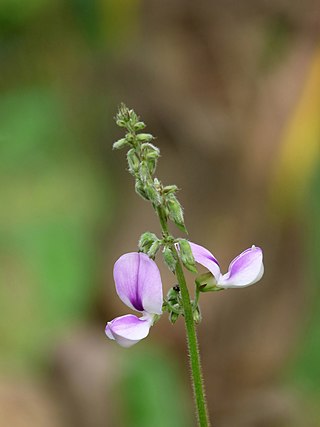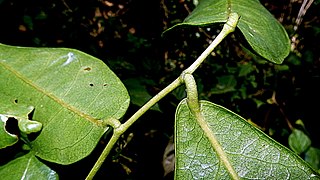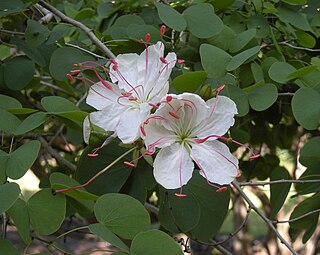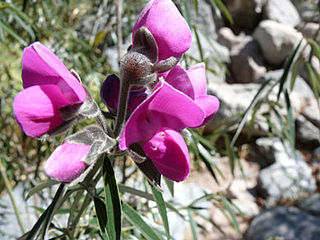
The Mimosoideae are a traditional subfamily of trees, herbs, lianas, and shrubs in the pea family (Fabaceae) that mostly grow in tropical and subtropical climates. They are typically characterized by having radially symmetric flowers, with petals that are twice divided (valvate) in bud and with numerous showy, prominent stamens.

Pueraria is a genus of 15–20 species of legumes native to south, east, and southeast Asia and to New Guinea and northern Australia. The best known member is kudzu, also called Japanese arrowroot. The genus is named after 19th century Swiss botanist Marc Nicolas Puerari.

The plant tribe Phaseoleae is one of the subdivisions of the legume subfamily Faboideae, in the unranked NPAAA clade. This group includes many of the beans cultivated for human and animal food, most importantly from the genera Glycine, Phaseolus, and Vigna.

Poecilanthe is a genus of flowering plants in the family Fabaceae. It includes 9 species of trees and shrubs native to eastern, southern, and west-central Brazil, Bolivia, Paraguay, Uruguay, and northeastern Argentina. They grow in seasonally-dry tropical forest, woodland, thicket, and riverine forest.

Lysiphyllum is a genus of flowering plants in the legume family, Fabaceae. It includes nine species of trees, semi-scandent shrubs, and lianas which range from India through Southeast Asia to Australasia. Typical habitats include seasonally-dry tropical forest and woodland, vine thickets, Brigalow and Gidgee scrubland, floodplains, alluvial flats, tidal forest, mangroves, river and stream banks, and occasionally dunes and coral islets. They can grow on diverse soils including calcareous, granitic, and basaltic.

Calopogonium is a genus of flowering plants in the legume family, Fabaceae. It includes eight species, which range through the tropical Americas from Mexico through Central America, the Caribbean, and northern South America to northeastern Argentina. It belongs to the subfamily Faboideae.

Camptosema is a genus of flowering plants in the legume family, Fabaceae. It includes five species native to South America, ranging from northeastern Brazil to Bolivia and northeastern Argentina. It belongs to the subfamily Faboideae and tribe Diocleae.
Clitoriopsis is a genus of flowering plants in the legume family, Fabaceae. It belongs to the subfamily Faboideae. The genus contains a single species, Clitoriopsis mollis, a subshrub native to South Sudan and Democratic Republic of the Congo. It grows in seasonally-dry tropical forest margins, woodland, and wooded grassland.

Collaea is a genus of flowering plants in the legume family, Fabaceae. It belongs to subfamily Faboideae and tribe Diocleae. It includes five species native to the southern tropical South America, ranging from Peru to northeastern Brazil and northeastern Argentina.

Galactia is a genus of plants in the legume family (Fabaceae). It belongs to the subfamily Faboideae and tribe Diocleae They do not have an unambiguous common name, being commonly called milk peas, beach peas or wild peas. They are perennial herbs or subshrubs with prostrate, climbing, or erect forms.

Harpalyce is a genus of flowering plants in the family Fabaceae. It belongs to the subfamily Faboideae. It includes 35 species of shrubs and small trees native to the tropical Americas. Their distribution is disjunct, ranging from Mexico to Nicaragua, Cuba, and northern to southeastern Brazil and Bolivia. Typical habitats include seasonally-dry tropical forest, warm-temperate humid forest, woodland, bushland and thicket, shrubland, and grassland. Most species are evergreen and flower during the dry season.

Hymenolobium is a genus of flowering plants in the family Fabaceae. It includes 14 species of trees native to Central America and northern South America, ranging from Honduras to Bolivia and southeastern Brazil. Most species are native to Brazil, the Guianas, and Venezuela, with one extending into Peru, another into Ecuador, and one native to Central America. Trees are typically very tall and emergent in tropical humid lowland rain forest.

Macropsychanthus is a genus of flowering plants in the legume family, Fabaceae. It belongs to the tribe Diocleae, subfamily Faboideae. The genus has 47 species with a pantropical distribution, ranging through the tropical Americas from southern Mexico to northeastern Argentina, west and central Africa, Madagascar, Indochina, Malesia, Papuasia, and Queensland.
Monopteryx is a genus of flowering plants in the family Fabaceae. It includes three species of trees native to the Amazon rainforest of northern South America, ranging through parts of Colombia, Venezuela, northern Brazil, and French Guiana. They grow in non-inundated lowland tropical rain forest on sandy soil. The genus belongs to subfamily Faboideae. Members of this genus produce hydroxypipecolic acids in their leaves.
Panurea is a genus of flowering plants in the legume family, Fabaceae. It includes two species of trees native to Colombia and northern Brazil. They grow in the lowland tropical Amazon rainforest on white sand. The genus belongs to tribe Ormosieae in subfamily Faboideae.

Pterodon is a genus of flowering plants in the legume family, Fabaceae. It includes four species of trees native to Brazil and Bolivia. Typical habitats include seasonally-dry tropical forest, woodland (cerrado), and thorn shrubland (caatinga), often on rocky outcrops. It belongs to the subfamily Faboideae.
Poissonia is a genus of flowering plants in the legume family, Fabaceae. It includes five species of trees, shrubs, and herbs native to Peru, Bolivia, and northwestern Argentina. Typical habitats include seasonally-dry tropical and subtropical forest and shrubland, generally along river and stream banks, and open vegetation in arid areas. It belongs to the subfamily Faboideae, tribe Robinieae.

The tribe Diocleae is one of the subdivisions of the plant family Fabaceae.
Bowringia is a genus of flowering plants in the legume family (Fabaceae), found in tropical Africa and southeastern Asia. It includes four species native to western and central Africa and Madagascar, and to Borneo, Indochina, and southern China.
Microcharis is a genus of flowering plants. It includes 36 species of herbs and shrublets native to Africa and the Arabian Peninsula. The genus is in tribe Indigofereae of family Fabaceae. Typical habitats include seasonally-dry tropical forest margins, woodland, thicket, wooded grassland, and grassland, often in damp, swampy, or riverine areas, or in shallow soil over rocks.













